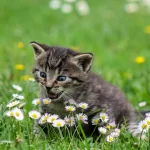
Caressing your cat strengthens the bonding relationship between you two, and relaxes both the animal and its owner. These daily taste buds are also important to get him used to being handled, and help detect skin diseases, the presence of parasites, lumps or pain on his body. No more reason to hold back!
Most of us don’t really need an excuse to pet our cat. It’s a safe bet that if we had a choice and no bills to pay, we would rather stay home to have some taste buds than go to work! Beyond the pleasure that this activity generates, it can be very useful for the well-being of your living room feline … and for yours!
1- Communicate love
Petting your cat is probably the best way to show him your affection: he loves petting and scratching which gives him a lot of pleasure. Caressing is a bit like the human equivalent of allogrooming, which means mutual licking in cats who know and appreciate each other: they lick each other to exchange their smells and deposit their soothing and reassuring pheromones. In return, Mimi rewards you by rubbing, licking or kneading you … and of course by purring!
2- Reduce stress
Being petted is a pleasant and relaxing activity for your cat, but it is also for you! Recent studies tend to prove that cats have beneficial effects on reducing stress, anxiety * and even blood pressure or cholesterol on bipeds.
You might also like: TIPS FOR CARING FOR YOUR CAT AFTER SURGERY
3- Get them used to being handled
As early as two weeks old , a kitten can gradually begin to be handled by humans to be socialized and used to being touched. You have to go slowly to avoid over-stimulating the little one, because it especially needs to be with its mother and siblings to develop correctly until weaning (between two and three months) . If you stroke him regularly and gradually, he will feel confident in your contacts when he grows up. This is particularly important, as it is easier to perform palpations on an animal that is used to being handled. If she has been taught to be touched by “strangers” (friends or family members who do not live with you), interactions withappointments with the vet will be better. This is especially true for a kitten, because in adulthood, there is a lot of learning. However, it is most of the time possible to get an older cat used to being dabbled, provided you are very patient!
4- Detect fleas and other external parasites
Petting your cat regularly familiarizes you with the feel of its skin and fur. This can make it easier for you to spot critters that want to suck his blood and cause itching and worms! Some of them, like fleas, multiply very quickly, so identifying them early can help eliminate them effectively before the situation gets out of hand. Never forget that in case of infestation by pests, you must treat your cat with preferably natural products (for example a flea shampoo , a dry shampoo , a powder , …) but also your home (with a spray or a diffuser) to avoid re-infestation! Malin, the electronic flea comb instantly removes unwanted critters without use of products and during the session caresses!
You might also like: How to make your cat happy?
5- Detect skin problems or lumps
Giving him papouilles can also help you quickly notice skin or internal problems, which are not visible because they are camouflaged by the coat: irritations, scratches, dry skin, dirty ears, or even cysts and lumps. This allows you to adopt the correct attitude, whether it is monitoring, treating or making an appointment with your veterinarian.
If you identify a wound, never use alcohol, mercurochrome, or human antiseptic sprays. Povidone iodine (“Betadine”) or a healing product suitable for animals are preferred. Likewise, in the event of dirty ears or eyes, it is better to avoid a dry cotton swab and to prefer a soft cloth moistened with a lotion of the appropriate composition.. Red, irritated or inflamed patches, especially if they have been present for a long time, require a veterinary consultation. In the meantime, and as first aid, a natural skin lotion can soothe your pet and make the marks disappear.
6- Detect a sensitive body part
Our tomcats really are the kings when it comes to hiding their pain, which is why it can sometimes take days or even weeks before you notice a tender or inflamed area. By loving it regularly, you can touch it “from every angle” and locate a painful area. While not particularly complaining, a cat will not easily let itself be touched where it hurts. A change in attitudes such as unusual growling or aggressiveness should alert you.
You might also like: What to know before adopting a stray cat
Remember that all of our tomcats have their own personalities and preferences. Their tastes in terms of cuddling vary: for example, some of them don’t like being touched on the stomach because it makes them feel too vulnerable. Be patient, and don’t rush them. Little sweet scratches on the tip of the chin, the ears and the top of the head, however, remain the favorite taste buds of our little living tigers!
Finally, if you notice an unusual sore or size, always consult your veterinarian: he is the only professional authorized to advise you on the health of your dear room mate.

Litter boxes are a necessary evil for cats. They produce all sorts of chemicals that shouldn’t be disposed of in the regular waste as they do their thing. There are plenty of ways to rid the litter box of smells without having to replace the entire fixture, but the more compact size of DIY litter boxes makes them handy and eco-friendly solutions. In addition, adding an enclosure to your existing litter box lets you conveniently clean and maintain this often vacant area. Not only does this save you from having to purchase expensive and frequently useless accessories, but it also cuts down on the number of times the litter box needs to be emptied. Here at catandwood, you can buy a cat litter box enclosure meager price than the other source online.
Add Trim Around the Cat Door

(Image credit: Excited Cats)
If you’ve ever been concerned about cats entering your home, a tiny, almost invisible cat door may be your answer. Use pine, birch, or oak trim to construct a cover to fit over your cat door. The door itself is simple to find at any hardware store or thrift store, and it can do most of the doorway opening sizes. You can also download some DIY plans for this project to get you started. Cover Your Cat Wall Wall-mounted cat toys can be a super fun way to play with your cats, but they can get a little distracting if you’re trying to focus on the task at hand – keeping the litter box area in good shape. Keeping them off the floor lets you keep an eye on them and helps prevent them from jumping on a nearby human or pet.
Put a Litter Box Inside a Large Basket

Image by All the Little Details via Pinterest.
- This DIY is an easy DIY to make. Just take an empty basket, make a door, add wheels, and you’re done!
- You will need about five boxes and wire wool. First, cut the wire wool to size and push it into the box. Then, put in a bag of litter and load the basket with small paper towels. Finally, roll it around until it looks good.
- For a nice finish, you can add a handle to the basket. DIY Kitty Styling Station
- For this nifty hack, insert the litter box into a tall cupboard, using an anchor point at the top and bottom of the door. Ensure the top of the closet is at least 4 inches off the floor so that the foot does not contact the litter box.
- Using screws, create an extra shelf inside the cupboard where the litter box is stored.
Build a Mini Cat House Litter Cover

(Image credit: Laura Gummerman)
This feline-friendly version of a litter box is the perfect addition to your home. Wacky Adornments to Match Your Cat’s Personality These buttons and baubles will take a boring litter box design to a whole new level. Practical DIY Feline-Friendly Cat Litter Box This clever DIY project requires a few simple supplies, including a box cutter, spray paint, scrap wood, and one vinyl sticker. Proper Utensils for Any Cat Litter Box These feline-friendly tools are excellent for decluttering the litter box and cleaning up any extra messes your cat leaves behind. A Perfect Feline Storage Solution With a purpose-built tray, you’ll never have to deal with a dirty litter box again.
Keep the Litter Cabinet Organized

(Image credit: IKEAhackers)
Whether your cat is scared to go inside their new home or they just haven’t been able to adjust, it’s best to keep their litter box separate from the rest of the house until they adapt to their new environment. By creating a unique cabinet in their new home, you can display their litter box prominently and keep it neat. You can even make this clean and organized space within your existing cabinet to add a pop of color to the otherwise drab fixture. In addition, incorporate other decorative pieces that will give your wardrobe a cozy feel, such as a decorative rug, cutesy souvenirs, or decorative art. Add the Option of Shading the View Having a hidden litter box in your home can be very important to some people, and your cats are no exception.
You might also like: TRAINING FOR CATS
Paint a Pattern on a Basic Litter Box Cover

(Image credit: sugarandcloth)
One of the most accessible and attractive DIY litter boxes we’ve seen is the metal-wrapped cat litter box. You can give the top of this litter box an eye-catching touch by painting it in the pattern of your choice. This makes it an excellent choice for any color scheme or theme you might have in mind. You can also grab a glue gun and craft another colored bottom for a different feel. Once you’re done painting, you can seal the whole thing in polyurethane for protection. Invest in Pet Litter Container Enclosures If you don’t want t o make any modifications to your cat litter box, you could always upgrade to something that comes with its own enclosure. There are plenty of options out there to choose from, but there is only one downside — they can be expensive.
Remove Drawers and Install a Hinged Door

(Image credit: TrueValue)
This homemade tin cabinet, built by Chris Coyne for Cat In The Boardroom, features a space-saving design with a “hinged door” that can be used to hide your litter box. After using this quick and easy kit, your little buddy can easily get in and out of the cabinet. Don’t worry about what smells are going to come out because all of your cat’s excrement will be contained in the litter box, keeping them safe from a bad case of the runs. Broom & Box Corner Not every guy is going to want to spend the money on a custom-made litter box, and you might not want to spend a ton of time building something for your home. You can always add a small corner bin and broom to help keep dirt and odors at bay. Get this DIY built-in for $20 in wood and another $12 in paint.
Hide the Litter Box Under the Sink

(Image credit: DigsDigs)
Get creative and make a cabinet or shelf that hides the dirty litter. A cabinet that offers cat access to food and water is a great idea. It’s a simple and effective idea that requires minimal investment. Make a Cat Tree A cat tree can also be a great hideaway for your litter box. Once built, it can be a safe resting place for your kitty for an extra special treat! You can create a perfect space for your little cat with this awesome floor mat inspired by cat furniture. Vintage Themed Cat Hideaway When we think of cats, we imagine them sleeping under a cozy blanket or lounging in front of the fireplace. A rustic cabin built like a classic log cabin can be an excellent home for cats. But this type of cabin that’s built of a large number of planks and logs can cause some noise.
Install a Cat Door in Wardrobe Cabinet

(Image credit: Rover)
If you have more than one cat, this clever trick is for you. This clever installation keeps cats safe from predators when they’re in the house and gives them access to the outdoors. You’ll need a wardrobe cabinet (like this one from Ikea) and a pet door (such as this one from Cover) installed. Install the door and store the litter in the cabinet with a special cat litter tray. Check out more great DIY bathroom makeovers and dog accessory ideas. Litter Box Bench for Cats and Dogs Cats and dogs both like to scratch, but we’ve found a simple solution that will protect your hardwood floors. Litter boxes can usually fit on top of our regular footstools, but they’re usually designed for larger animals.
Drape Fabric Around an End Table

(Image credit: sawsonskates)
A tabletop cat box is a brilliant solution when the tray on your cat-chaired end table is littered with mail, keys, and other items. Simply purchase a pet-proof litter box tray from the store and wrap it in a fabric panel. For a cleaner look, add an inexpensive clear vinyl sticker. The logo will look cute next to the tray’s paint. Transform a Den If you’re downsizing or moving, you can easily pick up a sturdy faux-wood rectangular platform, like this one from House Spirit. Add a piece of plywood below to provide the perfect base for the bed of your choice. We love the more rustic look of this cat box. It was made with reclaimed wood.
You might also like: Fun Facts about the Cat Paws
Add Curtains to a Console Table

(Image credit: Dimples and Tangles)
Just like the console table above, this DIY console table was a great way to hide a big task from our furry friends. Instead of having to clean up the litter box all the time, you can now hide the litter box inside the console table, keeping it safe from the mess. Undercover Litter Box Many DIY builders were quick to spot the clever utility of hiding a litter box in a drawer. Using a 2-drawer side and bottom dresser from IKEA, all you need is some hardware and furniture tape. As with many other home furniture DIY, this project will take a bit of time and patience. Thin-Lined Cat Bin There’s something special about looking through a cat-safe trash can. This DIY hack, which fits easily in the lid of your trash can, helps you keep the cat-toilet area clean and easy to clean.
Build a Custom Kitty Litter Box

(Image credit: Ikeahackers)
The Three Blind Mice Co. did a great job recreating this mint green masterpiece. This made-in-the-U.S. original shelter is a work of art that will delight you and your kitty alike. In the meanwhile, your animal friend will continue to enjoy a comfy and private seat. If you’re looking for something more modern and a little brighter, you can opt for this geometric-designed option from Campsite. It’s a great decor piece that has a lot of charm, but at the same time, the litter box does not look out of place. We also love that there are contrasting colors and textured materials to give the design some pizzazz. It looks like it belongs at a museum and will definitely add a lot of personality to your home.
Use the Inside of a Bench for Kitty Litter Storage

(Image credit: Foter)
This clever and affordable indoor bench is simple to build from spare wood. Once you’ve fashioned the hideaway box, you simply need to construct a shelf inside the bench to hold the litter. The floor also needs to be sealed, so you don’t track litter around the house. Cool Ways to Make a Small, Accent Crate a Little More Personality Choose a Cool Cat Litter Box Image Although it’s not as pretty as the modern, orange-and-black patent design below, this simple DIY outfitter keeps the lid accessible. Use an adhesive clamp to glue the lid to the platform before adding a shelf to store a scoop and a litter tray inside.
Convert a Bedroom Dresser into Litter Box Storage

(Image credit: HGTV)
This roomy, modern home entertainment center is completely full of storage for the comforts of your cats. You can buy a litter box, but you’ll probably want a good place to keep it during the day, too. When it comes to luxury cat furniture, the bed on this bed will offer a private, cozy spot to sit and snuggle. If you want to combine the two, just add some blanket. Turn a Pillow into a Cat Litter Box Cover It’s the perfect pillow for relaxing, but we have a better use for this pillow: as a cat box cover. It’s lightweight and functional, and there are several locations for litter box access (under the pillow, inside the pillow cover, and inside the head of the pillow). You can even extend the box out and use a bag of litter as a drop-in litter.
Repurpose a Tote for a Larger Litter Box

(Image credit: Barbara Adamcik)
Most people think of portable totes as places to store shopping bags, but this one is a better place to store the litter box. Watch this story for more details. Fix the Stinky Carpet With Paint Did you know you can paint your carpet? You can even find a pre-applied sealer to give your long-neglected carpet a shiny new look. The best part? It’s cheap and easy! Even Without a Carpet, it’s Still Easy to Hide a Litter Box By adding layers of paint, and you can create the illusion of a carpet in your home. This home design blogger is giving her downstairs bath a new look with a completely covered area. Add Litter Box Jars to a Rope Climb You can also create a climbable cat tree using climbing rings and big boxes. Watch this quick DIY to see how this system works.
Add Playful Decals Outside the Cat Door

(Image credit: Pets Lady)
Since the idea behind this hidden cat door is to prevent the litter box from getting scuffed up by being outside, a fun way to give the box a happy home is to create a play area for your cat. You can create a bright, colorful design to help your cat feel playful and stop them from scratching and marking up the door too much. Just choose your favorite decals online and watch them appear on the bottom of the door for an added touch of cuteness. Use Tape to Hide the Box From Extruders The best solution for this pesky issue of cat litter clogging up countertops, cabinets, and other hard-to-reach places? Use tape. You’ll find the best tape-in many department stores and drug stores for both home and office use.
Put the Cat Door on the Top of a Cabinet

(Image credit: Ikeahackers)
Make a litter box space hidden from sight. This ingenious solution uses a window ledge as a litter box door. With a few small upgrades (like screws) and wooden crates or crates with metal covers, your cat can enter and exit the litter box area with ease. Buy a trash can to conceal a litter box. Install a trash can and/or food dish on top of an entertainment center. The extra space and well-designed design make this litter box a practical option. Lay a sheet across a kitchen table to hide the cat litter box. Lay down a waterproof or thick plastic sheet to camouflage the litter box. Lay the sheet over the top of the table, then set up the litter box.
Create a Cat Walk to Remove Excess Litter

(Image credit: instructables)
Place this striking catwalk in the middle of your home or office to give your feline friends a private, comfortable place to take care of their business. It’s especially great for relieving the stress on your paws. Simply cut a piece of furniture in the shape of a U. Using long nails or screws, secure the ‘U’ on the wall or ceiling, creating a catwalk. Then, just add some cushioning for maximum comfort. Keep a Trim around the Toilet to Protect Your Porch No matter how you feel about litter boxes, and you have to admit they are useful. They’re low maintenance and cheap to buy, plus you can set one up at your front door to keep garbage out and for easy clean-up. This clever solution involves building a box to shield your front steps from the litter.
Cat need to access their own private space

(Image credit: instructables)
A new coat of paint on a baseboard or piece of furniture is a great way to transform the look and feel of a small space, and this DIY looks amazing and comes with surprisingly low maintenance. To create the cubby, first drill two holes in the baseboard, then attach two more small screws with the included hex key. Next, simply drill two holes for the metal stakes, attach them to the baseboard, and use the included screws to secure them in place. Repeat this process two more times around the baseboard for a total of four new holes. This simple custom make will hide the handle of your litter box and will allow your cat to access their own private space, so it can do its business without annoying you.
Conclusion

(Image credit: CatandWood)
Making a comfortable indoor litter box can be challenging. Fortunately, there are several solutions you can take advantage of to make it a comfortable space for your cats. Utilize these ideas, and your cats will love having their own cozy spot. And I Would say that the DIY cost a lot of time and money also, that it’s better to buy at catandwood.com instead of making it yourself. Have you tried one of these cool litter box projects? if so, share your thoughts in the comments below.

A litter box is a necessity for all cat owners, yet finding a great spot to put it has always been a problem. However, there are many types of litter box furniture available to help find a solution to this problem. We’ve looked into many different styles and cabinets and have found that the best cat litter box furniture is the Refined Cat Litter Box Deluxe from The Refined Feline.
Things you should consider when buying cat litter box furniture:
The Cost of The Litter Box Cabinet
As with all other products for our beloved cat, the cost is a big factor choosing the items we buy. Some manufacturers offer more expensive options but the features that they offer are the most important factor. Therefinedfeline.com offers a moderately priced option that is the best bang for your buck. Cheaper options are often made of material that can not hold up against odors and moisture. The last thing you want is for the cabinet to absorb anything from the litter. One good option for the cabinet to be made of is solid wood. This is exactly what this one from The Refined Feline is made of. It even includes a plastic liner on the inside to keep the litter in one place.
The Size of The Litter Box Cabinet
You might also like: TIPS FOR CARING FOR YOUR CAT AFTER SURGERY
When choosing the appropriate furniture for your cat, make sure that it will fit both your cat and the litter box. Many cabinets are only offered in one size but this one is offered in 2 sizes that will fit even an automatic litter box. You should also consider where you will be placing this cabinet in your home.
The Design of The Litter Box Cabinet
Some litter box furniture doesn’t take into account the design. However, unique modern cat furniture from The Refined Feline is all about design. Their furniture is offered in many different colors and designs. In fact, it’s customizable so that you can choose the door panel and foot design that you like. Not only does it look nice though, it is also functional. Inside of this cabinet you will find a storage drawer. In the back there are even ventilation slots. These slots can hold carbon filters to absorb the odors. This will prevent the odors from entering your home and will also keep the air fresh inside the cabinet.
The Accessibility of The Litter Box Cabinet
At the end of the day, it doesn’t matter what kind of litter box furniture you get if your cat can’t use it. Make sure that your cat is fully able to get in and out of the enclosure with ease. If your cat is older you may want to keep the enclosure lower to the ground and not put feet on it. You could also add a litter catch to not only catch the stray litter but to act as a step up.
In Conclusion: The Best Litter Box Cabinet
You might also like: Review of the Best Cat Litter Box Furniture
A cat litter box cabinet is a practical and functional way to hide the litter box and also make cleaning up easier. This solution is especially ideal if you are short on space and don’t have much of a choice when it comes to the litter box location.

Savannah cats are an ideal alternative to African servals. Savannah cats are very intelligent and can be adopted by dedicated individuals. Captive servals were being sold to pet shops and individuals who wanted an exotic pet.F1 Savannah cats are hybrids that are 50% domestic and 50% African serval. They are very easy to keep and are less likely to attack other cats.
F1 Savannah kittens are specifically bred to be aggressive. This makes them a safer choice for people who are afraid of wild animals. They have long legs and a distinctive appearance.
The F1 Savannah Kittens organization hopes that the more domesticated savannah cats will eventually replace the African servals as pets. African servals are very social animals and require a lot of space to roam. They are also hard to medicate and prefer isolation. F1 Savannah kittens are very popular among exotic pet lovers. Max thinks that these cats are ideal for people who have always wanted a wild cat. He said that they were created for those who would not be able to care for a cat that would be detrimental to their health.
We wanted to create a place where Savannah cats could be raised without being subjected to the cruel conditions that they were kept in.
You might also like: Fun Facts about the Cat Paws
These cats are very playful and love to play with toys. They are very good with children and are eager to learn.
Like French bulldogs, these cats are very affectionate and loveable. However, they can also be very territorial and cling to their owners.
Bengal cats are hybrids of a domestic cat and an Asian Leopard.
Bengal cats are known for their fur patterns and unusual body sizes. They are also known for their love for people. These cats are very affectionate and get along well with dogs. They’re often associated with French bulldogs. These pets have longer and fluffier coats than most bulldogs. According to John Carter, these pets are more affordable than the average price of rare specimens. Even cheaper French bulldogs of this nature can cost thousands of dollars.
French bulldogs have coats that can vary from black, blue, chocolate, fawn, isabella white, and lilac.
Due to the popularity of these animals on social media platforms, responsible breeders are taking extra care to ensure that these pets are kept safe and sound.




